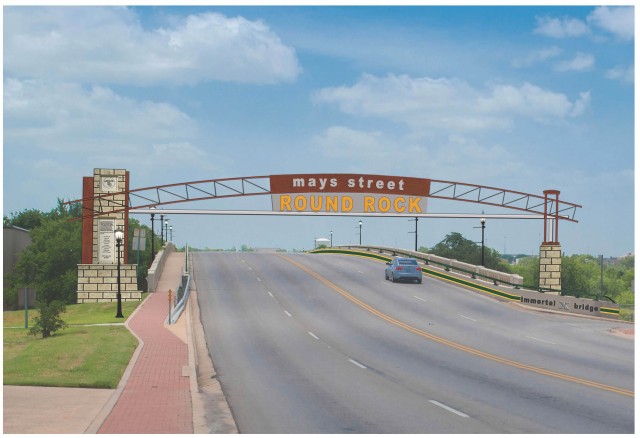
Courtesy Art

Courtesy Art
By Amanda Hayes
Reporter
Most Baylor students know the story of the Immortal Ten tragedy, and now so will the citizens and visitors of Round Rock.
A new memorial will be constructed at the site of the 1927 accident on Mays Street in downtown Round Rock and will be dedicated as the Immortal Ten Bridge.
“We recognize it’s not being properly memorialized at the location of the tragedy, and are trying to do everything possible now to make it a place where people understand the significance and stop to think about it,” said Alan McGraw, mayor of Round Rock.
The memorial is a part of a larger construction process in Round Rock to give citizens a historic downtown, and Brian Ligon, multimedia specialist for Round Rock and Baylor alumnus, said city officials recognize the bus crash as one of the most significant events in Round Rock history.
“This is something the mayor spearheaded, as he’s been talking with President Starr’s office for awhile,” Ligon said. “I was inspired because of my position within the city and as a Baylor grad, they are two things I’m passionate about.”
Will Hampton, communication director for Round Rock, said this felt like a great opportunity to raise visibility of the location and remind people of the tragedy.
Previously, the only local memorial to the collision was a plaque on the bridge dedicated by the State Highway Commission when it was opened. This marker is old, tarnished and could easily be missed, Ligon said.
“The more I thought about it, the more I realized what an incredible piece of Texas and really U.S. history this is,” McGraw said. “I noticed the pitiful plaque and thought, ‘We can do a whole lot better than this.’”
According to Bob Brinkman, coordinator of the Historical Markers Program for the Texas Historical Commission, the Baylor bus crash was a prime example of the numerous tragedies that occurred during the industrial revolution as new technology outpaced safety concerns.
The remainder of the 1927 season was canceled, according to Baylorbears.com, and the first railroad overpass in Texas specifically built for automobiles was constructed at the location of the accident in 1935.
As a direct result of the accident, federal laws were enacted requiring buses to stop before entering a railroad crossing, according to Community Impact Newspaper.
“It brought to light that road and railroad intersections are dangerous,” Ligon said. “It impacted the way we all travel, whether we know it or not.”
Immortal Ten is the name given to the ten members of the Baylor basketball team killed in a bus accident on Jan. 22, 1927 on the way to a game in Austin against the University of Texas men’s basketball team. The crash occurred when the Sunshine Special passenger train hit the bus at the intersection of Mays Sreet and the train tracks. The Immortal Ten are honored each year during Baylor Homecoming, when freshman hear the tragic story and participate in a candlelight remembrance ceremony.
Ligon said some Round Rock officials have referred to Todd Copeland’s book, “The Immortal Ten: The Definitive Account of the 1927 Tragedy and Its Legacy at Baylor University,” to get in-depth information on what happened.
Alan McGraw said the stars aligned for this process when the Union Pacific Railroad, that runs underneath the bridge, contributed $100,000 to the project.
The first Immortal Ten memorial on Baylor campus was dedicated during homecoming 2007. The monument of four life-sized bronze statues and a bas-relief panel of the other six student-athletes can be seen coming from Fifth Street toward Pat Neff in Traditions Square.
Downtown construction will break ground Monday, and is planned to be completed in the next 18-24 months, Ligon said. The last artist renderings of the memorial showed LED green and gold lighting, Ligon said, and it will be visible from I-35.
“It’s an amazing thing the city wants to do,” Ligon said, “To really have something tangible that reflects those students from so long ago, and to give Waco and the university the proper respect it deserves.”





